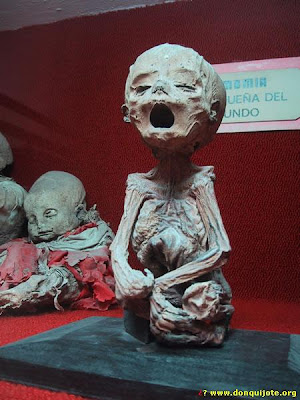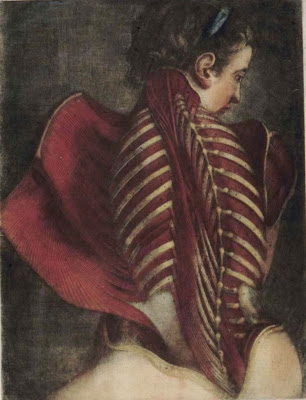 St Bartholomew was one of 12 Apostles and an early Christian martyr that was skinned. This statue was made by Marco d’Agrate in 1562 (Duomo cathedral, Milan-Italy). If you look closely, you’ll notice that’s not a robe, but actually his removed skin hanging around him. Such a macabre motif of the flayed Apostle carrying his own skin, was first met in The Last Judgment (Michelangelo) and continued to be a common representation, not only for St. Bartholomews in paintings, but also in the later artistic Anatomy manuscripts as I have posted some time before.
St Bartholomew was one of 12 Apostles and an early Christian martyr that was skinned. This statue was made by Marco d’Agrate in 1562 (Duomo cathedral, Milan-Italy). If you look closely, you’ll notice that’s not a robe, but actually his removed skin hanging around him. Such a macabre motif of the flayed Apostle carrying his own skin, was first met in The Last Judgment (Michelangelo) and continued to be a common representation, not only for St. Bartholomews in paintings, but also in the later artistic Anatomy manuscripts as I have posted some time before.
Πέμπτη 23 Ιουνίου 2011
St. Bartholomew statue in Duomo, Milan Cathedral
 St Bartholomew was one of 12 Apostles and an early Christian martyr that was skinned. This statue was made by Marco d’Agrate in 1562 (Duomo cathedral, Milan-Italy). If you look closely, you’ll notice that’s not a robe, but actually his removed skin hanging around him. Such a macabre motif of the flayed Apostle carrying his own skin, was first met in The Last Judgment (Michelangelo) and continued to be a common representation, not only for St. Bartholomews in paintings, but also in the later artistic Anatomy manuscripts as I have posted some time before.
St Bartholomew was one of 12 Apostles and an early Christian martyr that was skinned. This statue was made by Marco d’Agrate in 1562 (Duomo cathedral, Milan-Italy). If you look closely, you’ll notice that’s not a robe, but actually his removed skin hanging around him. Such a macabre motif of the flayed Apostle carrying his own skin, was first met in The Last Judgment (Michelangelo) and continued to be a common representation, not only for St. Bartholomews in paintings, but also in the later artistic Anatomy manuscripts as I have posted some time before.
Κυριακή 19 Ιουνίου 2011
Mummies in Guanajuato (Mexico)
 The Mummies of Guanajuato, Mexico, are a number of naturally mummified bodies interred during a cholera outbreak around Guanajuato, Mexico in 1833. These mummies were discovered in a cemetery located in Guanajuato, which has made the city one of the biggest tourist attractions in Mexico. All of these mummies were disinterred between 1865 and 1958, when the law required relatives to pay a tax in order to keep the bodies in the cemetery. If the relatives could not pay this tax, they would lose the right to the burial place, and the dead bodies were disinterred. Ninety percent of the bodies in the cemetery were disinterred because their relatives did not pay the tax. However, only 2% of them were naturally mummified.
The Mummies of Guanajuato, Mexico, are a number of naturally mummified bodies interred during a cholera outbreak around Guanajuato, Mexico in 1833. These mummies were discovered in a cemetery located in Guanajuato, which has made the city one of the biggest tourist attractions in Mexico. All of these mummies were disinterred between 1865 and 1958, when the law required relatives to pay a tax in order to keep the bodies in the cemetery. If the relatives could not pay this tax, they would lose the right to the burial place, and the dead bodies were disinterred. Ninety percent of the bodies in the cemetery were disinterred because their relatives did not pay the tax. However, only 2% of them were naturally mummified.  The mummified bodies were stored in a building and in the 1900s the mummies began attracting tourists. Cemetery workers began charging people a few pesos to enter the building where bones and mummies were stored. This place was turned into a museum called El Museo De Las Momias, The Mummies’ Museum. A law prohibiting the disinterring of more mummies was passed in 1958, but this museum still exhibits the original mummies. Due to the deadliness of the epidemic, more cemeteries had to be opened in San Cayetano as well as Cañada de Marfil. Many of the bodies were buried immediately to control the spread of the disease; in some cases, the dying were buried alive by accident. As a result, some of the mummies have horrific expressions attesting to their death in the tombs, though most expressions became fixed postmortem. One of the mummies who was buried alive was Ignacia Aguilar. She suffered from a strange sickness that made her heart appear to stop for one day on several occasions. During one of these incidents, her heart appeared to stop for more than the usual time. Thinking she had died, her relatives decided to bury her. When her body was disinterred, it was noticed that she was facing down, biting her arm, and that there was a lot of blood in her mouth. (wikipedia)
The mummified bodies were stored in a building and in the 1900s the mummies began attracting tourists. Cemetery workers began charging people a few pesos to enter the building where bones and mummies were stored. This place was turned into a museum called El Museo De Las Momias, The Mummies’ Museum. A law prohibiting the disinterring of more mummies was passed in 1958, but this museum still exhibits the original mummies. Due to the deadliness of the epidemic, more cemeteries had to be opened in San Cayetano as well as Cañada de Marfil. Many of the bodies were buried immediately to control the spread of the disease; in some cases, the dying were buried alive by accident. As a result, some of the mummies have horrific expressions attesting to their death in the tombs, though most expressions became fixed postmortem. One of the mummies who was buried alive was Ignacia Aguilar. She suffered from a strange sickness that made her heart appear to stop for one day on several occasions. During one of these incidents, her heart appeared to stop for more than the usual time. Thinking she had died, her relatives decided to bury her. When her body was disinterred, it was noticed that she was facing down, biting her arm, and that there was a lot of blood in her mouth. (wikipedia)




Δευτέρα 13 Ιουνίου 2011
"Scary Stories to Tell in The Dark", a children's horror book?
 "Scary Stories to Tell in The Dark" is a series of three children's books written by Alvin Schwartz and illustrated by Luis Erique, Daniel Urena, and Stephen Gammell. The scary stories of the title are pieces of folklore and urban legends collected and adapted by Schwartz. The titles of the books are: "Scary Stories to Tell in the Dark" (1981), "More Scary Stories to Tell in The Dark" (1984), and "Scary Stories 3 : More Tales to Chill Your Bones" (1991). The first volume was published in 1981, and the books have subsequently been collected in both a box set and a single volume. This series is listed as being the most challenged series of books from 1990–1999 and seventh most challenged from 2000-2009 by the American Library Association for its violence. Also there remains the problem of it being classified as a children's book, due to the surreal and nightmarish illustrations contained within. (wikipedia)
"Scary Stories to Tell in The Dark" is a series of three children's books written by Alvin Schwartz and illustrated by Luis Erique, Daniel Urena, and Stephen Gammell. The scary stories of the title are pieces of folklore and urban legends collected and adapted by Schwartz. The titles of the books are: "Scary Stories to Tell in the Dark" (1981), "More Scary Stories to Tell in The Dark" (1984), and "Scary Stories 3 : More Tales to Chill Your Bones" (1991). The first volume was published in 1981, and the books have subsequently been collected in both a box set and a single volume. This series is listed as being the most challenged series of books from 1990–1999 and seventh most challenged from 2000-2009 by the American Library Association for its violence. Also there remains the problem of it being classified as a children's book, due to the surreal and nightmarish illustrations contained within. (wikipedia)
Δευτέρα 6 Ιουνίου 2011
Jacques Fabien Gautier d'Agoty's artistic Anatomy Illustrations

The anatomical Angel (1746)
The image of a flayed woman entitled Anatomical Angel was viewed as highly controversial even during his lifetime. D’Agoty dubbed his image Anatomical Angel due to the flaps of skin pulled away from the cadaver’s back in a manner that suggests angel wings. Great attention has been devoted to the elegantly coiffed hair on her half-turned head. Her rosy cheek appears flush with life. D’Agoty’s aptly-titled Angel exists on a plane somewhere outside of death, rendering her an otherworldly creature. One cannot, however, quickly dismiss the artist’s decision to depict a young, conventionally beautiful and, yes, sexually attractive woman. Of course, D’Agoty knew his audience: scientists and people in the medical field, all of whom would’ve been men. (Lady Lazarus: dying is an art)

Pregnant woman (1773)
Jacques Fabien Gautier d'Agoty, born in Marseille to Paris in 1716 and died in 1785, is a painter and engraver of French anatomy. His colored mezzotints have a painterly quality. This pregnant woman calmly looks back at the viewer, a characteristic pose of 18th-century French portraiture.
Πέμπτη 2 Ιουνίου 2011
Album: Seasons in the Abyss. Band: Slayer (1990)
Another classic thrash metal album that makes a turn fron death and satanic thematology towards a more sociopolitical issues. Read more in allmusic
Εγγραφή σε:
Αναρτήσεις (Atom)





























.jpg)



